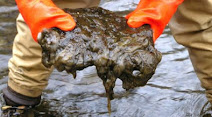Rock Snot - Didymosphenia geminata, commonly known as didymo, is a species
of diatom that produces nuisance growths in freshwater rivers and streams with consistently cold water temperatures and low nutrient levels. It is native to the northern hemisphere, and considered an invasive species in Australia, Argentina, New Zealand, and Chile. Even within its native range, it has taken on invasive characteristics since the 1980s. It is not considered a significant human health risk, but it can affect stream habitats and sources of food for fish and make recreational activities unpleasant. This microscopic alga can be spread in a single drop of water.Native range
Adverse effects
Preventing further spread
The following methods have been recommended to prevent the spread of didymo in New Zealand:
Check: Before leaving the river, remove all obvious clumps of algae and look for hidden clumps. Leave them at the site. If you find clumps later don't wash them down the drain, treat them with the approved methods below, dry them and soak them in bleach for at least 4 hours.
Clean: Soak and scrub all items for at least one minute in either hot (60 °C) water, a 2% solution of household bleach, antiseptic hand cleaner, or dishwashing detergent.
Dry: If cleaning is not practical (e.g. livestock, pets), after the item is completely dry wait an additional 48 hours before contact or use in any other waterway.
New Zealand and the U.S. states of Alaska, Maryland, South Dakota and Vermont have banned anglers from wearing felt-soled boots. Orvis, a leading U.S. manufacturer of fly-fishing equipment, has started selling more rubber-soled boots than felt-soled.
Sea Snot - Marine mucilage, or sea saliva is a collection of mucus-like organic matter found in the
sea. The creamy, gelatinous substance is generally not harmful, but can attract viruses and bacteria, including E. coli, and it can become a blanket that suffocates the marine life below. It is frequently seen in the Mediterranean Sea and has recently spread to the Sea of Marmara.Causes
Effects
The significant increase in the amount of sea snot in 2021 in Turkey suddenly became a political issue as well as an environmental issue. The growth in snot that year was exponential as it reached a tipping point in the Mediterranean and other seas. Sea snot was observed clumping at least as early as 2009. Some overgrowth is partly due to climate change. Warmer, slower moving waters increase the production of sea snot and allow it to accumulate in massive blobs. Sea snot was first reported in 1729 and has long been seen as a nuisance to the fishing industry and coastal populations. Recently, sea snot has emerged not only as a nuisance, but as a major hazard. Its not just that globs of snot can harbor bacteria such as E. coli which threaten maritime flora and fauna, as well as humans exposed to contaminated water but sea snot can also coat the gills of sea creatures subsumed in it, cutting off oxygen and killing them.
The Deepwater Horizon oil spill in the Gulf of Mexico created large amounts of sea snot. Scientists are not sure how exactly the spill caused so much sea snot to form, but one theory asserts that the sea snot could have been the result of a massive kill of microscopic marine life creating a "blizzard" of marine snow. Scientists worry that the mass of sea snot could pose a biohazard to surviving marine life in the area. It is widely believed that the sea snot left by the spill directly resulted in the loss of sea life in the Gulf of Mexico, as evidenced by a dead field of deepwater coral 11 kilometers from the Deepwater Horizon station.
In early 2021, sea snot spread in the Sea of Marmara, due to pollution from wastewater dumped into seawater, which led to the proliferation of phytoplankton, and posed a great threat to the marine biome. The port of Erdek at the Sea of Marmara was covered by the sea snot, in which Turkish workers embarked on a massive effort to vacuum up the slimy marine mucilage in June 2021. At that time it was not clear how to remove the underwater mucilage. Yalıköy port in Ordu Province also witnessed accumulating mucilage in June 2021, in the Black Sea.




















